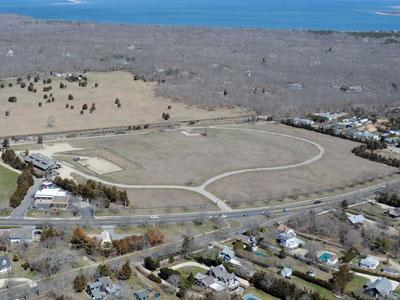Ambitious Plan Targets Baby Boomers

A Connecticut-based developer pitched an 89-unit senior citizen housing development, on the site of the former Principi property on Montauk Highway east of Amagansett, to the hamlet’s citizens advisory committee at its meeting Monday evening.
Francis Jenkins III of Putnam Bridge and Jaquelin Robertson of the New York-based architects Cooper, Robertson and Partners described the 23.5-acre development, which they call 555, to a large assembly of committee members and guests. Promising an open process and willingness to listen to all opinions, they said there was a need for housing designed with the active, vibrant senior citizen in mind as well as sustainability in new-building construction.
With 63 cottages and 26 apartments, the market-rate residences, at an average footprint of 1,550 square feet, would be priced between $850,000 and $1.8 million. Taxes paid to the town, presently $40,000 a year, would rise to almost $2 million, Mr. Jenkins said. “We’re meeting with a tax assessor this week or next,” he said.
Persons 55 and older would be eligible to live on the site. Units are to be designed for living on a single floor; those with a second story would feature an extra bedroom, study, or living space for a caregiver. The principals estimate a total occupancy of about 135, and promised not a gated community but, in their words, “an extension of Amagansett Village.”
“This is the first sustainable project in this region,” Mr. Robertson told the crowd. “Sandy was a precursor. There are going to be more of them, and they are going to come at different times. Every project has to take that into account.”
Mr. Jenkins promised a complex that would produce as much electricity as it consumed, with photovoltaic panels atop the south and west portion of roofs and a “zero-wastewater community” that would produce no nitrogen. “On the West Coast, parts of New Jersey, in Europe, this is everyday technology,” he said. The layout, which includes roads, parks, a pond, a field house, a greenhouse, and a fitness center, would take advantage of summer winds and encourage walking and an active, outdoor lifestyle, said the developer.
East Hampton Town has three affordable-housing complexes for senior citizens, but no market-rate housing for the large baby boomer generation now entering retirement years, they said. “There are a lot of people designing toward assisted living [and] the different stages of 24-hour medical care. But there is no one designing toward the active-living senior facility,” said Mr. Jenkins.
Today’s senior citizens, said Mr. Robertson, “are incredibly energetic and intend to live a rich and full life until they die. To have a place that they can go to in smaller, simpler surroundings, in this particular area, is superb.” He also emphasized the comparatively modest footprint of the residences. “Goodbye to the McMansion, re-welcome the cottage, which was the greatest building type in this part of the world for 150 years,” he said.
In order for the plan to proceed, a new overlay district for senior citizen housing would have to be established at the site. Richard Whalen, an Amagansett-based attorney, prepared proposed legislation to that end, which the developers submitted to the town planning board last month.
“This site is not zoned for senior housing,” Mr. Jenkins said. “That’s not lost on us, and that’s a major issue. The [town’s comprehensive] plan of 2005 talks a lot about senior housing, but there is no mechanism within the zoning code for senior housing. . . . That’s what we’re asking the town to start discussing: senior housing as a section of the code.”
Several committee members pressed the men for additional details, but with a limited timeframe and another speaker scheduled (a separate story appears on this page), Kieran Brew, the committee’s chairman, said further discussion could await a future meeting.
“We want to be completely open and have a professional discourse around this,” Mr. Jenkins said. “We’re not trying to push this through in the middle of the night, so to speak. We want to have a robust discussion.”
“Do you see this as being a year-round community?” asked Betty Mazur, a committee member.
“Yes,” he replied. “It’s designed as a year-round community. That’s very important for vibrancy of the community.”
“The prices being what they are,” she said, “do you think that’s realistic?”
“I do. That’s the thing I’m least worried about,” he said.
“I have a feeling Mr. Jenkins is going to be a regular here,” said Mr. Brew. “It sounds like this is a long process, because you have legislation to enact before you can even talk about breaking ground.”
